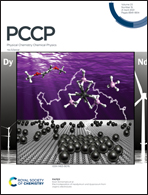Electron-induced fragmentation mechanisms in organic monomers and their implications for photoresist optimization for EUV lithography†
Abstract
Secondary electrons generated during the Extreme Ultraviolet Lithography (EUVL) process are predominantly responsible for inducing important patterning chemistry in photoresist films. Therefore, it is crucial to understand the electron-induced fragmentation mechanisms involved in EUV-resist systems to improve their patterning performance. To facilitate this understanding, mechanistic studies were carried out on simple organic EUV-resist monomers, methyl isobutyrate (MIB) and methacrylic acid (MAA), both in the condensed and gas phases. Electron-stimulated desorption (ESD) studies on MIB in the condensed phase showed desorption peaks at around 2 and 9 eV electron energies. The gas-phase study on MIB showed that the monomer followed the dissociative ionization (DI) fragmentation pathway, under single collision conditions, which opened up at electron energies above about 11 eV. No signs of dissociative electron attachment (DEA) were detected for MIB in the gas phase under single collision conditions. However, DEA was an active process in MAA in the gas phase under single collision conditions at around 2 eV, showing that slight modifications of the molecular structures of photoresists may serve to sensitize them to certain electron-induced processes.

- This article is part of the themed collection: 2021 PCCP HOT Articles


 Please wait while we load your content...
Please wait while we load your content...